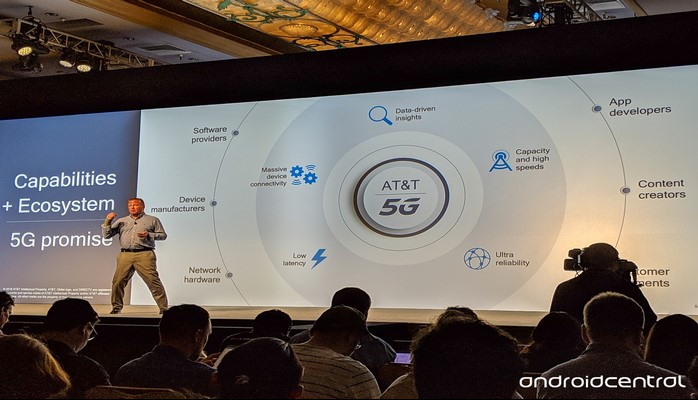
What is 5G Technology?
5G is coming, but most of us aren't really sure what it is or why we want it. A big part of the reason is that 5G means more than one thing, and depending on who you ask you'll get different answers. That makes it a lot like 4G, which was equal part marketing term as well as real technology.
Technically speaking, 5G is the next generation of broadband connection. At first, 5G will live beside and enhance your current 4G service, but soon enough 5G-only networks will be complete and stand-alone 5G devices will be available. With any type of 5G connection, you'll see faster network speeds, but the biggest changes will happen when carriers have all deployed high-frequency millimeter wave technology to tap radio wavelengths that have been unusable in the past.
We're already seeing carriers put 5G networks into place for testing and evaluation. Both "real" 5G networks and fake 5G networks like AT&T's 5G Evolution network that's really just 4G with extra bandwidth. But because of how 4G LTE is going to be enhanced by and eventually replaced with 5G, it will be a while until everything is up and running and "real" 5G is everywhere.
All about the frequency

Think of 5G as broken into two parts — I'll call them low-frequency 5G and high-frequency 5G.
Low-frequency networks will use the same radio bands that current technology uses, but changes to signal encoding (primarily channel polarization which Huawei used to obtain 27Gbps speeds using existing networks) and wider channel bands will allow for speeds up to 50% better than the best 4G LTE network has to offer today.
Networks using these changes will also still be able to have the same range that they currently have, which means no additional cell sites are needed to maintain the same network footprint. Some new equipment will need to be installed at existing sites, though, and carriers are getting everything 5G-ready in preparation.
New ways to compress and send data can make 4G seem as fast as 5G, but the real innovation requires microwaves.
But the newer — and better — technology behind 5G is using higher-frequency spectrum. Spectrum available in wavelengths like 28GHz allows for very fast and very "wide" channels for broadband service to communicate over because they aren't congested and clogged by devices that use it today. Known as millimeter wave frequency, these channels have one significant drawback — the signals don't travel nearly as far as the lower-frequency signals do.
We see this in action today. Verizon's 4G LTE service uses lower frequencies than Sprint. When the network isn't crowded with plenty of customers, Verizon will have higher speeds further away from any cell site than Sprint will because Sprint's higher-frequency signal just doesn't travel as far or penetrate solid substances as well.
Faster connections usually don't have much range.
Your home Wi-Fi router is an even better example. 802.11 a/b/g 2.4GHz networks use narrow 20MHz channels to transmit and receive data. 802.11 n 5GHz networks use 40MHz wide channels, and 802.11 ac 5GHz networks use 80MHz wide channels. When you're connected to your wireless access point with a 2.4GHz connection on a much more narrow channel, the speeds are slower than when connecting at 5GHz when you're very close to the router but stay fairly consistent as you move further away. 5GHz connections, especially wireless ac connections, have a much more limited range because the signal strength drops off quickly.
To offset this, millimeter wave 5G will require much small cell sites that are much closer to each other. This is the only way to keep the ultra-high frequencies safe enough to use, because if the signal gain was increased enough to allow for long-distances at those frequencies some serious health issues would occur. Communication over these radio bands isn't something new, so all the pitfalls are well known and the right precautions have been taken.
When do I get 5G?

- AT&T says it will have a true 5G network live in 19 cities and has test sites up and running in 12 cities across the U.S. This is in addition to its "5G Enhanced" 4G LTE network the company is also pushing.
- Sprint is repurposing its current 2.5GHz network for 5G and is currently retrofitting its cell sites as well as making all new sites "5G-ready".
- T-Mobile is using both its 600MHz network and 28GHz network bands to have a 5G network in place sometime in 2019, with a complete nationwide rollout by 2020.
- Verizon is using millimeter wave 5G for its current home 5G broadband and says it will have a mobile network in place sometime during 2019.
Of course, what all that really means is that you will need new devices in order to see any sort of 5G network for yourself. Qualcomm has designed chips that will be ready for 5G in its current form and will also be ready as the tech matures and minor changes are made. We also know that Samsung is making 5G phones for Verizon, AT&T, and Sprint as well as carriers in Europe, OnePlus will have Europes first 5G-ready phone to launch on EE sometime this spring, and that Huawei is ready for 5G in Asia as well as the places in North America where the company still does business. By mid-2019 seeing every phone manufacturer talking about a 5G phone shouldn't surprise anyone.
We've also seen a few mobile hotspots that can leverage these new (and in many cases unavailable) 5G networks by Netgear and others. This drives home one very important 5G feature that doesn't get enough attention — it can compete with wired broadband internet. A fully built network in the millimeter wave range of the spectrum can have as much capacity as a wired network using today's tech. And unlike a fiber-based network, there won't be a group of workers with a backhoe in your yard installing it.
What this all means right now

In the short term, 5G benefits the carrier as much or more than the consumer. The initial costs of new equipment will be offset by the savings over maintaining the current aging infrastructure, the ability to actually compete in home broadband service without resorting to fiber will gain more customers, all 5G devices in the U.S. will be carrier-specific, and some of the costs will be passed on to the customer like always.
Long term is a different story. The sheer amount of data that can be transferred at high speeds means that 5G will be able to do a lot more than bring fast downloads to your phone. Distance learning, connected devices that work with other connected devices as well as connected municipalities and towns, and many other applications that need high bandwidth and low latency are just a dream today because there isn't a network that can handle them. 5G might just change all of that.
Your phone doesn't need a faster network; at least until someone invents a reason why it does.
Source : Android Central



Comments
Show comments Hide comments